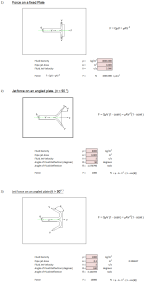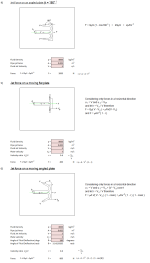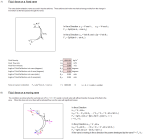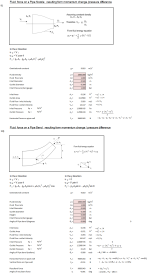Fluid Jets
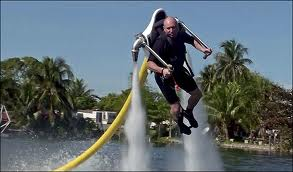
Description
Forces Resulting from fluid jets , flow over plate, vanes and through pipes
Calculation Reference
Roymech.co.uk. https://roymech.co.uk/Related/Fluids/Fluids_Jets.html
Purpose of Calculation
To calculate the force resulting from the fluid momentum changes from impacting plates, from flowing over vanes and flowing through pipes.
The various calculations have been checked against each other and against examples in the identified references. Notes providing background for the calculations are provided on the above website.
The study of forces resulting from the impact of fluid jets, and when fluids are diverted, involves the application of Newtons second law in the form of F = m.a. The forces are determined by calculating the change of momentum of the flowing fluids. In nature these forces manifest themselves in the form of wind forces, and the impact forces of the sea on the harbour walls. The operation of hydro-kinetic machines such as turbines depends on forces developed through changing the momentum of flowing fluids.
In its simplest form, with steady flow conditions, the force on a fluid flow in a set direction is equal to its mass flow rate times by the change in velocity in that set direction. The fluid flow also exerts an equal and opposite reaction force as a result of this change in momentum.
These are ideal values and do not take into account losses due to friction or the effect of gravity
F = m. (u1 - u2) = Q? (u1 - u2) = V.A.? (u1 - u2) . ..( F and u are vector quantities)
F= Force in set direction on component changing the direction of flow.
m. = mass flow rate kg/s
Q= volume flow velocity (m3/s)
? = fluid density (kg/m3)
u1 & u2 = flow velocities before and after contact with component m/s
V = velocity of jet. m/s Note: V is generally equal to to u1
A = Area of jet. m2
1) Fluid force on a flat fixed plate
2) Fluid force on a angled fixed plate ( 90o )
3) Fluid force on a angled fixed plate ( > 90o )
4) Fluid force on a angled fixedplate ( = 180o )
5) Fluid force on a flat moving plate
6) Fluid force on an angled moving plate
7) Fluid force on a static vane
8) Fluid force on a moving vane
9) Fluid Force on a pipe nozzle
10) fluid Force on a pipe bend
Calculation Reference
Mechanical Engineers Data Handbook Carvill
Mechanics of Fluids Massey
Fluid Mechanics
Forces resulting from fluid jets, flow over plates, vanes, and through pipes are important considerations in fluid mechanics and engineering. These forces are created by the interaction between the fluid and the solid surfaces, and can have significant effects on the performance and efficiency of various systems, such as pumps, turbines, and heat exchangers.
Fluid jets: The force resulting from a fluid jet depends on the velocity and mass flow rate of the jet, as well as the angle and shape of the surface it impacts. The force can be calculated using the formula F = ρQV, where F is the force, ρ is the density of the fluid, Q is the mass flow rate of the jet, and V is the velocity of the jet.
Flow over plates: The force resulting from fluid flow over a plate depends on the velocity and viscosity of the fluid, as well as the shape and orientation of the plate. The force can be calculated using the formula F = 1/2ρAV^2Cd, where F is the force, ρ is the density of the fluid, A is the cross-sectional area of the plate, V is the velocity of the fluid, Cd is the drag coefficient, and 1/2ρAV^2 is the dynamic pressure of the fluid.
Vanes: The force resulting from fluid flow over vanes depends on the shape and orientation of the vanes, as well as the velocity and viscosity of the fluid. The force can be calculated using the formula F = ρQVsin(θ - α), where F is the force, ρ is the density of the fluid, Q is the mass flow rate of the fluid, V is the velocity of the fluid, θ is the angle of the vane relative to the flow direction, and α is the angle of the jet or fluid flow.
Through pipes: The force resulting from fluid flow through a pipe depends on the velocity and viscosity of the fluid, as well as the diameter and roughness of the pipe. The force can be calculated using the formula F = ρQV, where F is the force, ρ is the density of the fluid, Q is the mass flow rate of the fluid, and V is the velocity of the fluid.
These forces resulting from fluid jets, flow over plates, vanes, and through pipes can be used to analyze and design various fluid systems, and are critical for ensuring efficient and effective operation.
Calculation Preview
Full download access to any calculation is available to users with a paid or awarded subscription (XLC Pro).
Subscriptions are free to contributors to the site, alternatively they can be purchased.
Click here for information on subscriptions.

